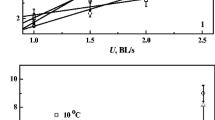Abstract
The physiological condition of jack mackerel [18.3 ± 1.2 cm fork length (FL), n = 24] was simultaneously monitored using electrocardiography (ECG) and electromyography (EMG) techniques during swimming exercise in a flume tank at different temperatures of 10, 15 and 22 °C. To monitor the effect of temperature on the threshold level of the maximum sustainable speed, EMG demonstrated that the initiation of ordinary muscle activity at the lowest temperature (10 °C) occurred at swimming speeds of 3.2–3.5 FL/s, which was slower than the activation speeds at 15 and 22 °C of 4.0–5.4 FL/s. Ordinary muscle became active with increasing swimming speed which subsequently resulted in the frequency, amplitude and duration of burst discharge. ECG and EMG monitoring showed that the heart rate started to increase at the sustained speed level before the threshold and markedly increased up to the maximum level of heart rate at the higher speed. The index of ordinary muscle power output at the lowest temperature of 10 °C was lower than at higher temperatures of 15 and 22 °C. The heart rate increased with the increasing power output of ordinary muscle for all temperatures.








Similar content being viewed by others
References
Webb PW (1994) Exercise performance of fish. In: Jones JH (ed) Advances in veterinary science and comparative medicine, vol 38 (B). Academic Press, Orlando, pp 1–49
Johnston IA (1981) Structure and function of fish muscles. Symp Zool Soc Lond 48:71–113
Johnston IA, Davison W, Goldspink G (1977) Energy metabolism of carp swimming muscles. J Comp Physiol 114:203–216
Weihs D (1974) Energetic advantages of burst swimming of fish. J Theor Biol 48:215–229
Tsukamoto K (1984) Contribution of the red and white muscles to power output required for swimming by the yellowtail. Nippon Suisan Gakkaishi 50:2031–2042
Breen M, Dyson J, O`Neill FG, Jones E, Haigh M (2004) Swimming endurance of haddock (Melanogrammus aeglefinus L.) at prolonged and sustained swimming speeds, and its role in their capture by towed fishing gears. ICES J Mar Sci 61:1071–1079
Nofrizal Yanase K, Arimoto T (2009) Effect of temperature on the swimming endurance and post-exercise recovery of jack mackerel Trachurus japonicus as determined by ECG monitoring. Fish Sci 75:1369–1375
Riyanto M, Yanase K, Arimoto T (2014) Temperature and fatigue effect on the maximum swimming speed of jack mackerel Trachurus japonicus. Fish Sci 80:53–59
Riyanto M, Arimoto T (2014) Temperature effect on heart rate of jack mackerel Trachurus japonicus, during swimming exercise. Fish Sci 80:1241–1248
Hanyu I, Tsukamoto K, Yamamori K, Ngan PV, Furukawa K, Hibiya T (1979) Simultaneous recording of physiological information from swimming fish. Nippon Suisan Gakkaishi 45:1261–1265
Xu G, Arimoto T, Inoue M (1993) Red and white muscle activity of the jack mackerel Trachurus japonicus during swimming. Nippon Suisan Gakkaishi 59:745–751
An YI, Arimoto T (1994) Heart rate change of jack mackerel by strobe light frequency. Nippon Suisan Gakkashi 63:3–9 (in Japanese with English abstract)
Ito H, Akiyama S, Arimoto T (2003) Heart rate change during exercise and recovery for carp Cyprinus carpio. Nippon Suisan Gakkashi. 69:192–196 (in Japanese with English abstract)
Amornpiyakrit T, Arimoto T (2007) Muscle physiology in escape response of kuruma shrimp. Am Fish Soc Symp 49:587–599
Brett JR (1964) The respiratory metabolism and swimming performance of young sockeye salmon. Fish Res Bd Can 21:1183–1226
Tsukamoto K (1984) The role of the red and white muscles during swimming of the yellowtail. Bull Jap Soc Sci Fish 50:2025–2030
Coull KA, Jermyn AS, Newton AW, Henderson GI, Hall WB (1989) Length/weight relationship for 88 species of fish encountered in the North East Atlantic. Scott Fish Res Rep 43:81
Bainbridge R (1960) Swimming and stamina in three fish. J Exp Biol 37:129–153
Bone Q, Kicenuik J, Jones DR (1978) On the role of different fibre types in fish myotomes at intermediate swimming speeds. Fish Bull 76:691–699
Johnston IA, Moon TW (1980) Endurance exercise training in the fast and slow muscles of a teleost fish (Pollachius virens). J Comp Physiol 135:147–156
Bone Q (1966) On the function of the two types of myotomal muscle fibres in elasmobranch fish. J Mar Biol Assoc UK 46:321–349
Xu G, Arimoto T, Inoue Y (1993) The measurement of muscle fatigue in walleye pollock (Theragra chalcogramma) captured by trawl. ICES Mar Sci Symp 196:117–121
Altringham JD, Johnston IA (1990) Modelling muscle power output in a swimming fish. J Exp Biol 148:395–402
Altringham JD, Wardle CS, Smith CI (1993) Myotomal muscle function at different locations in the body of swimming fish. J Exp Biol 182:191–206
Özbilgin H, Wardle CS (2002) Effect of seasonal temperature changes on the escape behavior of haddock Melanogrammus aeglefinus, from the codend. Fish Res 58:323–331
Arimoto T, Xu G, Matsushita Y (1993) Muscle contraction time of captured walleye pollock Theragra chalcogramma. Nippon Suisan Gakkashi 57:1225–1228
Author information
Authors and Affiliations
Corresponding author
Rights and permissions
About this article
Cite this article
Riyanto, M., Arimoto, T. Heart rate and muscle performance during forced swimming of jack mackerel Trachurus japonicus at different temperatures. Fish Sci 81, 1083–1090 (2015). https://doi.org/10.1007/s12562-015-0932-1
Received:
Accepted:
Published:
Issue Date:
DOI: https://doi.org/10.1007/s12562-015-0932-1




